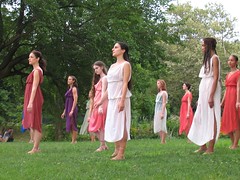Isadora Duncan - 1877 - 1927 - was an American artist of movement and costume who freed women from the constraints of traditional dance forms, especially ballet.
Angela Isadora Duncan was born in San Francisco, California, the youngest of the four children of Joseph Charles Duncan (1819–1898), a banker, mining engineer and connoisseur of the arts, and Mary Isadora Gray (1849–1922), youngest daughter of Thomas Gray, a California state senator, and his wife Mary Gorman, says Wikipedia.
In her early years, Duncan did attend school but, finding it to be constricting to her individuality, she dropped out. Owing to an untimely divorce and reverse in her family's fortune, there was no extra money. Both she and her sister gave dance classes to local children to earn extra money.
In 1895 Duncan became part of Augustin Daly's theater company in New York. She soon became disillusioned with the form. In 1899 she decided to move to Europe, first to London and then a year later, to Paris. Within two years she achieved both notoriety and success.
Montparnasse's developing Bohemian environment did not suit her. In 1909 Duncan moved to two large apartments at 5 rue Danton, where she lived on the ground floor and used the first floor for her dance school. Barefoot, dressed in clinging scarves and faux-Grecian tunics, she created a primitivist style of improvisational dance to counter the rigid styles of the time. She was inspired by the classics, especially Greek myth. She rejected traditional ballet steps to stress improvisation, emotion and the human form. Duncan believed that classical ballet, with its strict rules of posture and formation, was "ugly and against nature"; she gained a wide following that allowed her to set up a school to teach.
Duncan became so famous that she inspired artists and authors to create sculpture, jewelry, poetry, novels, photographs, watercolors, prints and paintings of her. When the Théâtre des Champs-Élysées was built in 1913, her likeness was carved in its bas-relief over the entrance by sculptor Antoine Bourdelle and included in painted murals of the nine muses by Maurice Denis in the auditorium.
Tuesday, April 27, 2010
Subscribe to:
Post Comments (Atom)





No comments:
Post a Comment